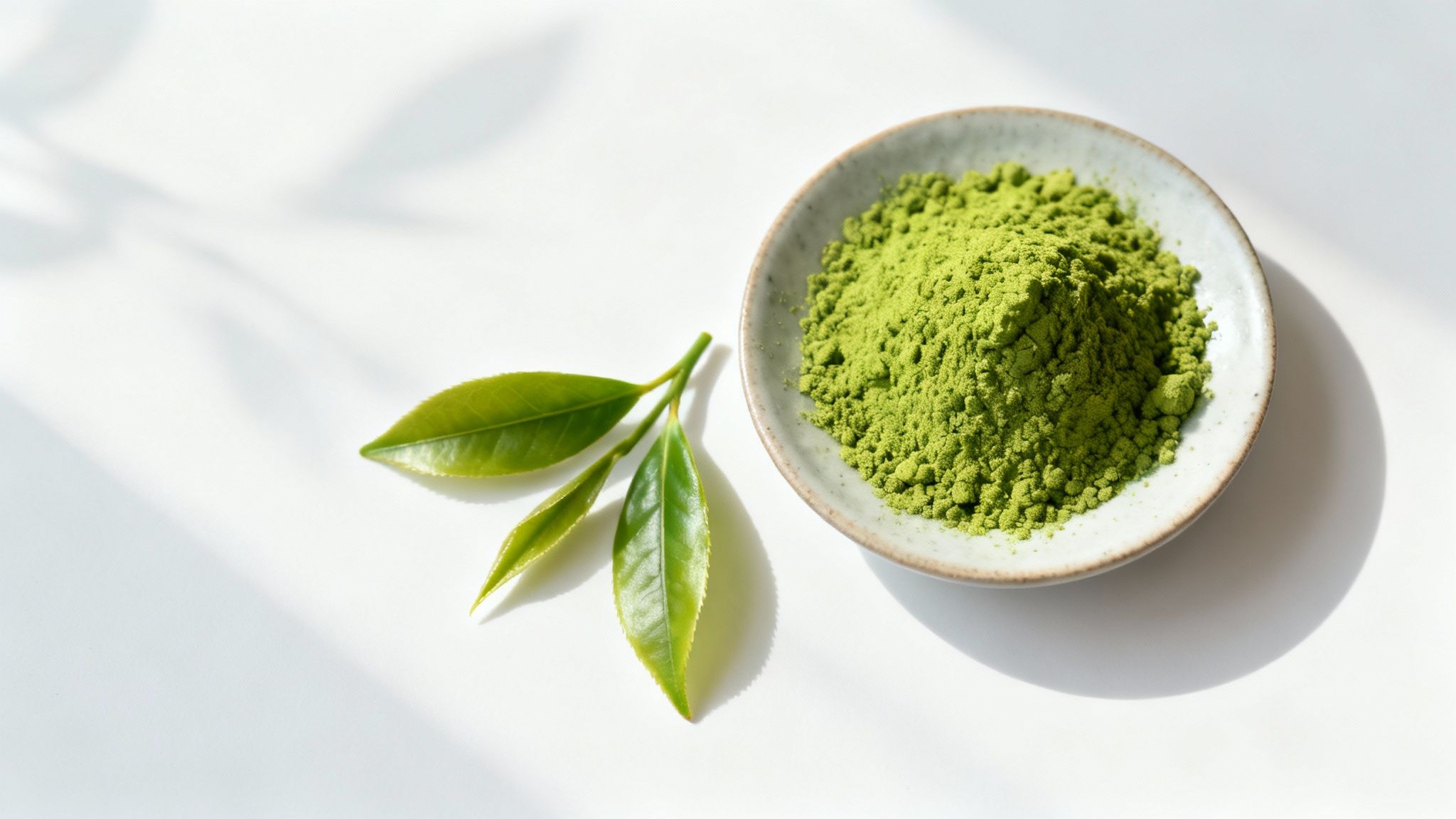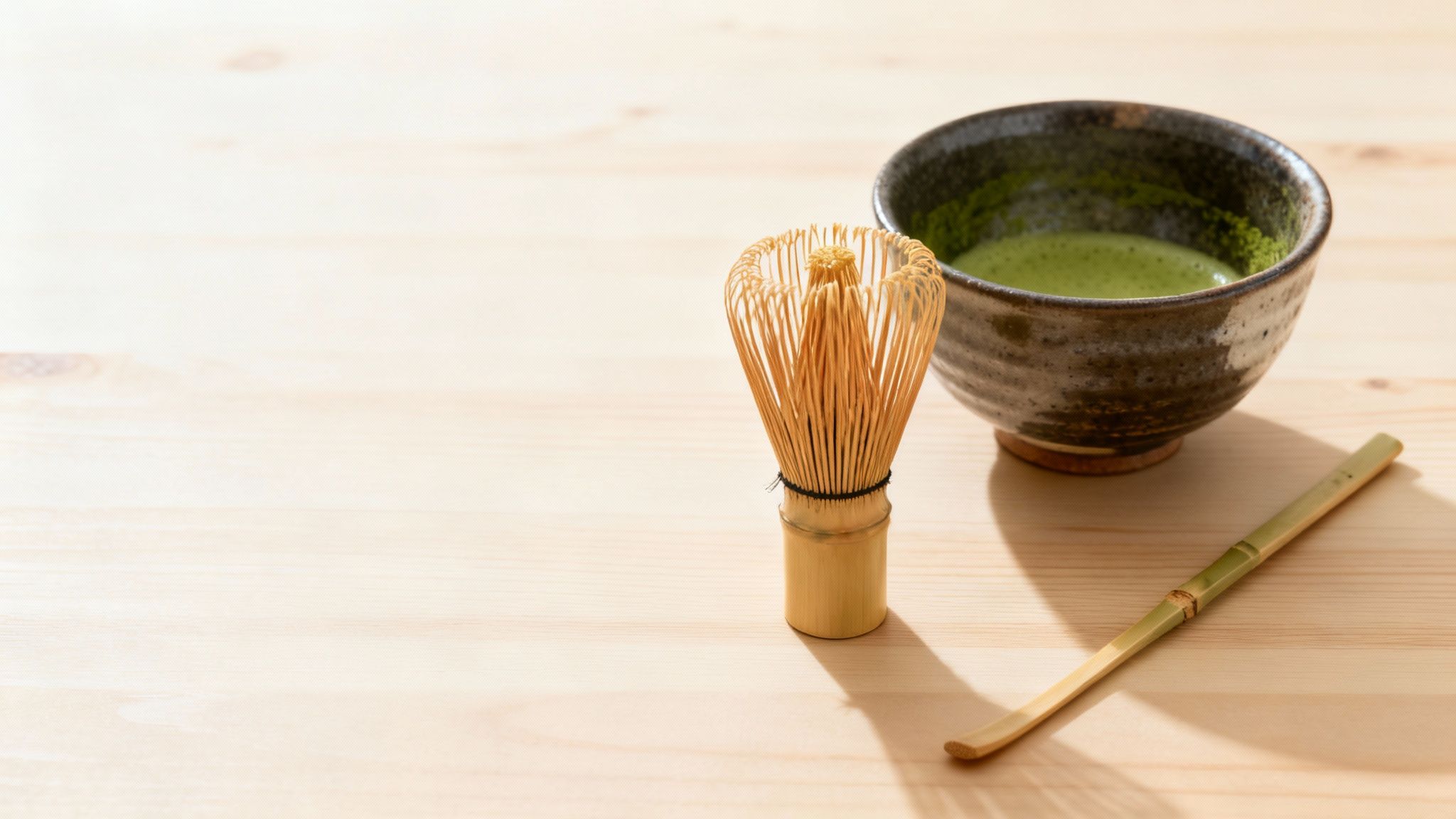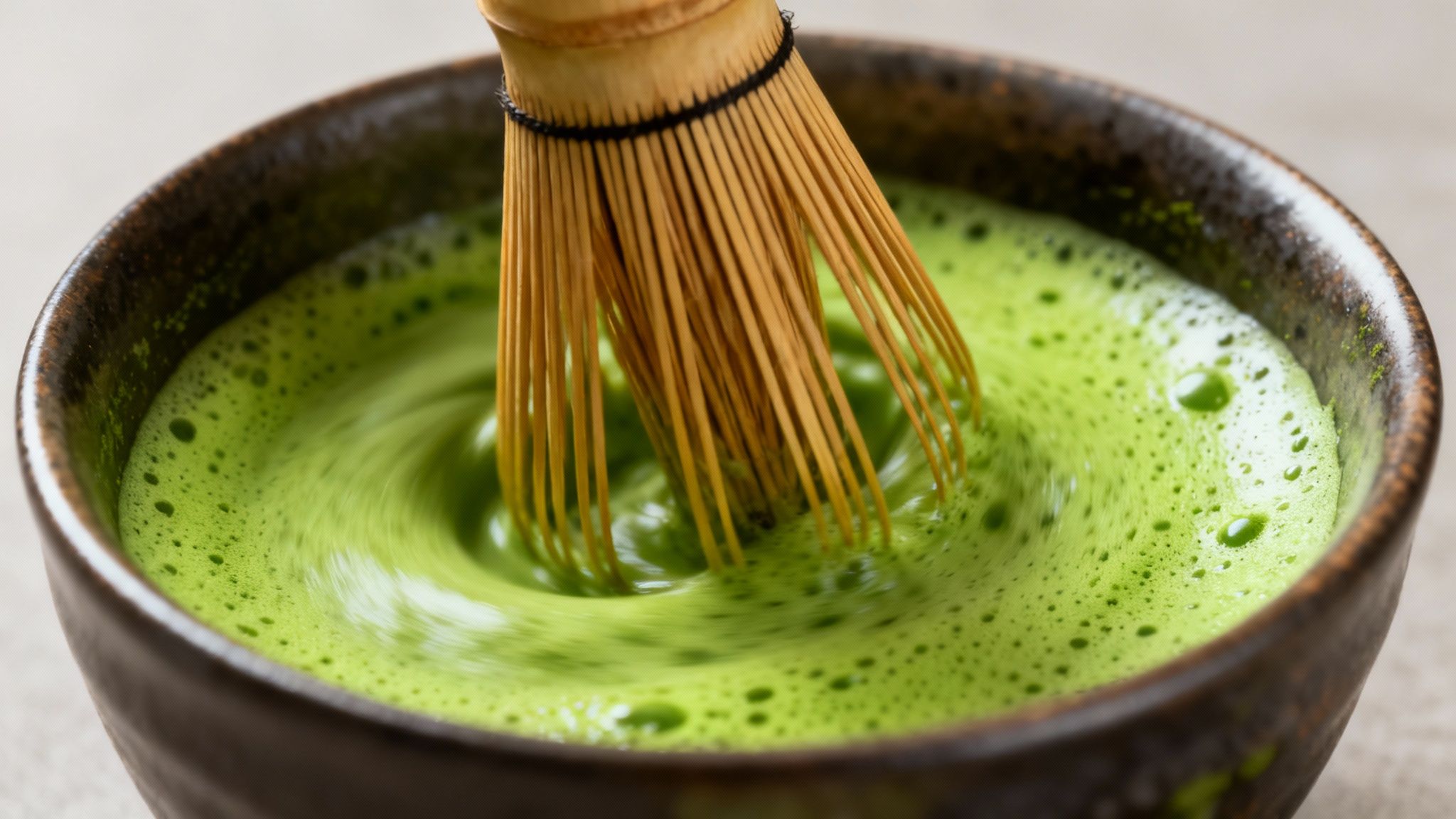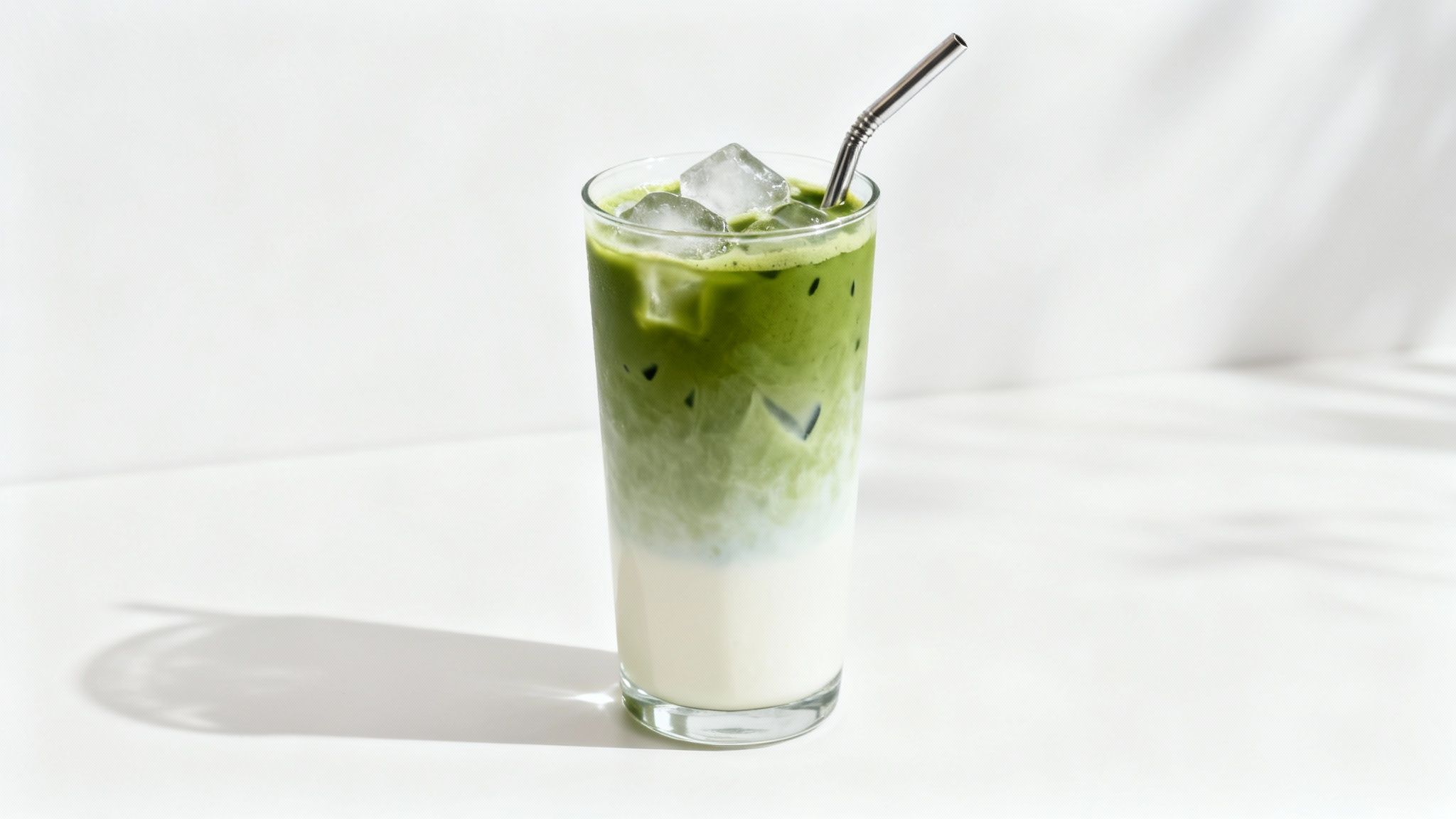Making matcha green tea is a simple, beautiful ritual. You just whisk the vibrant, finely ground tea powder with hot water until a lovely, smooth froth forms on top.
This method is special because you're actually consuming the entire tea leaf, rather than just steeping it and throwing it away. It’s a mindful process that rewards you with a uniquely rich, umami flavour and a wonderfully creamy texture.
Understanding What Makes Great Matcha

Before you even think about whisking up your first bowl, it’s worth knowing what separates the good stuff from the rest. This isn’t your everyday green tea. Its magic comes from a really meticulous growing process where the tea plants are kept in the shade for a few weeks before they're harvested.
Shading the plants boosts their chlorophyll and L-theanine levels, which is what gives the powder that brilliant green colour and its complex, savoury flavour we call umami.
This careful process explains why matcha has become so much more than just a drink; it's a real wellness staple. Its popularity is through the roof, tapping into a huge interest in healthier drinks. In fact, the UK matcha tea market was valued at around 127.5 million USD and is expected to hit 518 million USD by 2035.
Choosing the Right Grade
Getting to grips with the different grades is key to a great matcha experience. You'll mainly come across two types:
- Ceremonial Grade: This is the absolute best quality, made from the youngest, most tender tea leaves. It has a delicate, naturally sweet taste and is meant to be enjoyed simply with hot water.
- Culinary Grade: Made from slightly older leaves, this grade has a stronger, slightly more bitter profile. It’s absolutely perfect for lattes, smoothies, and baking, where its bold flavour can really shine through.
Knowing the different types of matcha tea will help you pick the perfect powder for whatever you have in mind.
To truly get the most from your matcha, you need to be precise. Understanding how proper kettle temperature control enhances your tea experience is a game-changer. If your water is too hot, it will scorch the delicate powder and leave you with a bitter, disappointing taste.
Choosing Your Matcha Making Tools

To whip up a smooth, frothy bowl of matcha, having the right gear can make a world of difference. While a beautiful ceremonial set is a lovely thing to own, you absolutely don't need one to get started. Great results are well within reach using items you probably already have in your kitchen.
The main goal is simple: get that fine green powder to dissolve without lumps, creating a delicate layer of foam on top. The traditional tools are designed perfectly for this, but a bit of kitchen creativity goes a long way.
Let’s have a look at the classic setup and then explore some brilliant everyday stand-ins.
The Traditional Matcha Set
A classic Japanese set is built around three key pieces, each with a specific job to do. Think of them as the artist's brushes for the craft of making tea.
- Chasen (Bamboo Whisk): This is the heart of the operation. Its 100 or so fine, flexible tines are expertly crafted to break up any clumps and whisk air into the tea, creating that signature velvety froth.
- Chawan (Tea Bowl): More than just a cup, its wide, flat bottom gives you the perfect canvas for whisking. It allows for the rapid ‘W’ or ‘M’ motion needed to build a proper foam.
- Chashaku (Bamboo Scoop): This elegant, curved scoop is designed to measure out just the right amount of matcha powder—roughly one gram per scoop.
Everyday Kitchen Alternatives
Don't have a traditional set? Don't let that stop you. The trick is to find tools that can sift, measure, and froth just as effectively. Plenty of people make fantastic matcha every day with common kitchen gadgets.
Getting the tools right doesn't have to be complicated. Whether you're a purist or a pragmatist, there's a setup that works. We've put together a quick comparison to show you how a few bits from your kitchen can stand in for the traditional Japanese tools.
Essential vs Everyday Matcha Tools
| Traditional Tool | Purpose | Everyday Alternative |
|---|---|---|
| Chawan (Tea Bowl) | Provides a wide, flat base for effective whisking. | A cereal bowl or a wide mug. |
| Chashaku (Bamboo Scoop) | Measures approximately one gram of matcha. | A 1/2 teaspoon measuring spoon. |
| Chasen (Bamboo Whisk) | Sifts, mixes, and froths the tea simultaneously. | A small sieve and an electric milk frother. |
As you can see, you can easily get started without a big investment. The most important thing is simply to enjoy the process of making your tea.
The secret to a truly smooth texture is breaking up the clumps before you add water. Matcha powder is incredibly fine and loves to static-cling into little balls. A quick sift is the one step you really shouldn't skip for a silky finish.
A small, fine-mesh sieve is your best friend here. For whisking, an electric milk frother is a game-changer and a brilliant substitute for the chasen, whipping up a fantastic foam in seconds. In a real pinch? You can even shake the matcha and water vigorously in a sealed jar. It works
Mastering The Art of Whisking Matcha

This is where the real magic happens. Preparing a traditional bowl of usucha (thin tea) is a mindful practice, turning a few simple ingredients into something truly beautiful and invigorating. Don't let the process intimidate you—it’s less about rigid rules and more about a few key techniques that make all the difference.
The first non-negotiable step is to sift your matcha. It’s a fine green powder that loves to clump together, thanks to a bit of static. Skipping this will almost guarantee a lumpy, uneven brew.
Just push one to two grams (about half a teaspoon) through a small, fine-mesh sieve into your chawan (tea bowl). It’s a tiny action that is your secret to achieving a silky-smooth texture.
The Perfect Water Temperature
Next up, the water. This is crucial. Using boiling water is one of the most common mistakes, and it's the quickest way to scorch the delicate tea, leaving you with a bitter, unpleasant flavour.
The ideal temperature is around 80°C (175°F). No temperature-controlled kettle? No problem. Just boil the water and let it sit for a minute or two to cool down.
Pour about 60 ml (2 ounces) of the hot water over your sifted matcha. Now you're ready to whisk.
A Quick Tip from Experience: Before you start, give your bamboo whisk (chasen) a quick soak in warm water for a minute. This softens the tines, making them more flexible and much less likely to snap while you're whisking.
The growing appetite for high-quality tea experiences like this is clear. In the UK, sales of matcha-based drinks shot up by a remarkable 202% in a recent year, showing a major shift towards premium, natural wellness beverages. You can explore more about this global trend and the expanding matcha market in this detailed industry analysis.
The Whisking Motion
Now, hold your chasen lightly, almost like you’re holding a pen. The secret is to let the power come from your wrist, not your entire arm. This allows for quick, nimble movements.
Instead of stirring in circles, you want to trace a rapid 'W' or 'M' pattern back and forth across the bottom of the bowl. Be vigorous—you’re not just mixing, you’re aerating the tea to build that lovely foam.
After about 15-20 seconds, you’ll know you’re done when the matcha has completely dissolved and a beautiful, creamy layer of tiny bubbles blankets the surface. This delicate froth is the hallmark of a well-prepared bowl of matcha.
For a deeper dive, check out our guide on preparing matcha tea perfectly every time. With these simple yet crucial steps, you can consistently create matcha that’s smooth, flavourful, and deeply satisfying.
Creative Matcha Recipes Beyond the Bowl

While the ritual of preparing a traditional bowl of matcha is something special, its incredible versatility is what has really catapulted it into the modern limelight. The powder's complex, earthy flavour profile works beautifully with so many other ingredients, opening up a whole world of delicious possibilities to fit any routine.
From creamy lattes to vibrant sodas, these modern takes are a fantastic way to enjoy matcha’s benefits, especially if you find the traditional flavour a bit too intense on its own. Playing around with different styles keeps things exciting and makes matcha accessible for everyone.
My Go-To Iced Matcha Latte
This is the drink I find myself making most mornings. It's a café-quality treat that you can easily whip up at home, and the secret to getting that perfect layered look you see all over social media is simply in how you build the drink.
Here’s the simple method:
- Make your matcha shot. Sift one teaspoon of culinary-grade matcha into a small bowl. Pour in 60 ml of hot (but not boiling) water and give it a vigorous whisk until it’s perfectly smooth and frothy.
- Sweeten (if you like). If you have a sweet tooth, now is the time to stir your favourite sweetener—honey or maple syrup works a treat—into the hot matcha until it’s dissolved. Let it cool for a moment.
- Assemble your latte. Grab a tall glass and fill it to the brim with ice. Pour 180 ml of your milk of choice over the ice. I find oat and almond milk work beautifully here.
- Create those layers. Now for the fun part. Slowly and carefully pour the matcha shot over the milk. You'll see it cascade through the ice, creating that stunning, photo-worthy effect.
To really nail the layers, it all comes down to density. The colder and denser your milk, the better the matcha will float on top before it slowly starts to blend. Using plenty of ice is a great trick for creating that initial separation.
Other Refreshing Matcha Variations
Beyond the much-loved latte, matcha’s unique character lends itself to all sorts of inventive drinks. These are perfect for a mid-afternoon pick-me-up or as a sophisticated non-alcoholic option when you have guests.
- Sparkling Matcha: Prepare a matcha shot as you normally would, but let it cool completely. Pour it over ice, top it up with sparkling water, and finish with a squeeze of fresh lime for a crisp, refreshing fizz.
- Matcha Americano: For a bolder, more direct matcha experience, simply pour your prepared shot over ice and top it with cold water. It’s a clean, pure way to appreciate the tea's profile without any milk to soften it.
And its use doesn't stop at drinks. For a truly creative breakfast idea that’s sure to impress, have a look at these wonderful matcha pancake recipes.
Troubleshooting Your Brew
Is your matcha coming out bitter, lumpy, or just… flat? Don’t be disheartened. These are classic teething problems when you're getting to grips with making matcha at home. A few small adjustments to your technique will make a world of difference, getting you that perfect, frothy cup you're after.
If your matcha tastes bitter, the number one culprit is almost always water that's too hot. You can’t just pour boiling water straight from the kettle onto that delicate green powder. It burns it, simple as that, killing all those lovely, complex, sweet notes. The sweet spot is around 80°C. Just let your kettle sit for a minute or two after it clicks off before you pour.
Then there's the dreaded clumping. Matcha is an incredibly fine powder, which means it loves to stick together. Once you add water, those little lumps are nearly impossible to whisk away.
Getting a Smooth, Frothy Finish
The secret to a silky, lump-free bowl of matcha is all in the prep. You absolutely have to sift your matcha powder. Pushing it through a small, fine-mesh sieve before adding water is non-negotiable in my book. It breaks up every last clump and aerates the powder, making it a dream to dissolve.
Struggling to get that signature frothy head? It could be your whisking action, or it might just be the matcha itself. Make sure you’re using a quick 'W' or 'M' motion from the wrist, not a lazy circular stir. But honestly, some lower-grade powders just won't foam up, no matter how vigorously you whisk.
Your choice of matcha powder makes the biggest impact on flavour, colour, and froth. Investing in a good quality ceremonial grade powder often solves taste and texture problems instantly.
It's also worth knowing that finding top-notch matcha here in the UK has become a bit more of a challenge recently. Extreme weather in Japan has caused global shortages, pushing prices up and making it harder for shops to get their hands on the good stuff. You can read up on the matcha shortage here, which really highlights why finding a reliable supplier is more important than ever.
A Few Common Matcha Questions
Getting into matcha always brings up a few questions. Let's walk through some of the most common ones that crop up when you're just starting out, so you can get the best possible flavour from your bowl.
What's the right water temperature for matcha?
This is probably the biggest one. Whatever you do, never use boiling water. It completely scorches the delicate tea leaves and you’ll be left with a really bitter, unpleasant taste. The sweet spot is around 80°C (175°F).
How long does matcha powder last?
People often ask if matcha powder goes bad. It doesn't "spoil" like milk, but it definitely loses what makes it special over time. The vibrant green colour, the fresh, grassy aroma, and a lot of the good stuff inside will all fade.
For the best flavour and froth, you really want to use your matcha within about two months of opening it. Keep it in an airtight tin in the fridge to help it stay fresher for longer.
Can I make matcha ahead of time?
I get why people ask this, but honestly, it's best enjoyed the moment it's whisked. If you let it sit, the powder will start to settle at the bottom, and you'll lose that beautiful, creamy foam. It only takes a minute to whisk up a fresh bowl, and the difference in taste and texture is absolutely worth it.
Discover the difference that quality makes. For an authentic taste of Japan, explore the premium ceremonial and culinary grade powders from Jeeves & Jericho and find your perfect matcha at https://www.jeevesandjericho.com.


